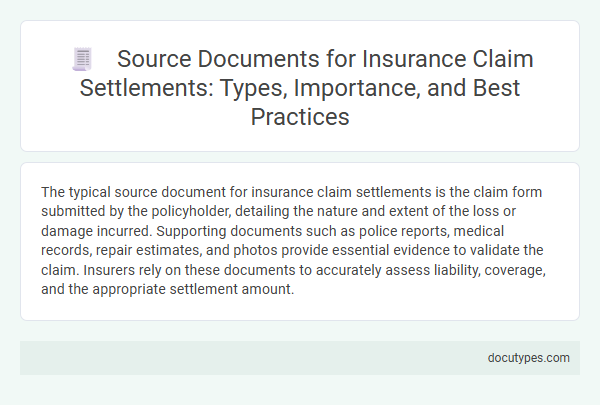The typical source document for insurance claim settlements is the claim form submitted by the policyholder, detailing the nature and extent of the loss or damage incurred. Supporting documents such as police reports, medical records, repair estimates, and photos provide essential evidence to validate the claim. Insurers rely on these documents to accurately assess liability, coverage, and the appropriate settlement amount.
Introduction to Source Documents in Insurance Claims
Source documents are essential in the insurance claim settlement process. These documents provide verified information needed to assess the validity and amount of a claim. Common examples include policy contracts, accident reports, medical records, and repair estimates.
Key Types of Source Documents for Insurance Settlements
Insurance claim settlements require accurate source documents to verify and process claims efficiently. These documents provide essential information about the claim's validity and the extent of coverage.
- Claim Form - The primary document completed by the policyholder detailing the incident and requested compensation.
- Police Report - An official record used in claims involving accidents or theft to confirm the event's occurrence and specifics.
- Medical Records - Verified health documents supporting personal injury claims, outlining treatments and diagnoses.
- Repair Estimates - Detailed cost assessments from certified service providers for vehicle or property damage repairs.
- Proof of Loss - A formal statement by the insured outlining the extent and value of the loss experienced.
Importance of Accurate Documentation in Claim Processing
The typical source document for insurance claim settlements is the claim form submitted by the policyholder. This document provides essential details about the incident, damages, and requested compensation.
Accurate documentation is crucial in the claim processing as it ensures that all relevant information is clearly recorded and verifiable. Precise records help insurance adjusters assess the validity and extent of the claim, reducing the risk of errors and fraud. Proper documentation speeds up the settlement process and improves communication between the insurer and claimant.
Policyholder’s Role in Document Preparation
What is the typical source document for insurance claim settlements? The primary source document is the insurance claim form completed by the policyholder. This form provides essential information about the incident and the extent of the loss.
How does the policyholder contribute to the preparation of claim documents? You play a crucial role by accurately filling out the claim form and submitting all supporting evidence. Your detailed and timely documentation ensures a smoother settlement process.
Common Challenges with Insurance Source Documents
The typical source document for insurance claim settlements is the claim form submitted by the policyholder. This document contains essential details needed to process and validate the claim efficiently.
- Incomplete Information - Missing or inaccurate details in claim forms can delay settlement and require additional verification.
- Document Authenticity - Fraudulent or tampered documents pose significant risks to accurate claim processing.
- Data Discrepancies - Inconsistencies between submitted documents and policy records complicate claims adjudication.
Addressing these challenges is critical to ensuring timely and accurate insurance claim settlements.
Best Practices for Collecting and Submitting Claim Documents
The typical source document for insurance claim settlements is the claim form submitted by the policyholder. This document provides detailed information about the incident, damages, and coverage request necessary for processing the claim.
Best practices for collecting and submitting claim documents include ensuring all forms are fully completed and accurate. You should also gather supporting evidence such as photos, receipts, and medical reports to streamline claim approval and avoid delays.
Digital vs. Paper Source Documents: Pros and Cons
The typical source document for insurance claim settlements includes police reports, medical records, and repair invoices. These documents provide the evidence needed to verify and process claims efficiently.
Digital source documents offer faster access, easier storage, and improved accuracy through automated data extraction. Paper documents, while traditional, can be prone to loss, damage, and slower retrieval times.
Regulatory Requirements for Claim Documentation
| Aspect | Details |
|---|---|
| Typical Source Document | Insurance claim settlements primarily rely on the Insurance Claim Form as the central source document. This form captures essential details about the claim, including the policyholder's information, claim nature, coverage specifics, and loss or damage description. |
| Supporting Documents | Supporting documents often include police reports, medical reports, repair estimates, invoices, and photographs. These documents validate the claim and provide evidence for loss or damage. |
| Regulatory Requirements | Regulatory bodies mandate strict documentation standards to ensure transparency, accuracy, and fraud prevention. Complete and accurate claim forms along with verifiable supporting documents are required for compliance. Records must be maintained for set periods in accordance with jurisdictional laws. |
| Your Role | You must provide all necessary documentation promptly and accurately to facilitate claim settlement and ensure regulatory compliance. Failure to provide adequate source documents could delay or invalidate the claim process. |
How Insurers Verify and Authenticate Source Documents
The typical source document for insurance claim settlements includes bills, invoices, and proof of payment related to the insured loss. Insurers verify and authenticate these documents through detailed checks to ensure legitimacy and accuracy before approving claims.
- Invoices and Bills - These documents detail charges related to repairs, medical services, or replacements, serving as primary evidence for claims.
- Verification Process - Insurers cross-check the documents against policy coverage and transaction authenticity using internal databases and third-party validation.
- Authentication Techniques - Techniques such as digital timestamp verification, contact with service providers, and fraud detection algorithms are employed to confirm document validity.
What Is the Typical Source Document for Insurance Claim Settlements? Infographic

